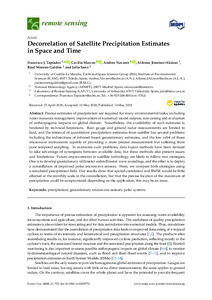Por favor, use este identificador para citar o enlazar este ítem:
http://hdl.handle.net/20.500.11765/11676
Decorrelation of satellite precipitation estimates in space and time
Registro completo de metadatos
| Campo DC | Valor | Lengua/Idioma |
|---|---|---|
| dc.contributor.author | Tapiador, Francisco Javier | es_ES |
| dc.contributor.author | Marcos Martín, Cecilia | es_ES |
| dc.contributor.author | Navarro Martínez, Andrés | es_ES |
| dc.contributor.author | Jiménez Alcázar, Alfonso | es_ES |
| dc.contributor.author | Moreno Galdón, Raul | es_ES |
| dc.contributor.author | Sanz, Julia | es_ES |
| dc.date.accessioned | 2020-04-24T09:43:35Z | - |
| dc.date.available | 2020-04-24T09:43:35Z | - |
| dc.date.issued | 2018 | - |
| dc.identifier.citation | Remote Sensing. 2018, 10(5), 752 | es_ES |
| dc.identifier.issn | 2072-4292 | - |
| dc.identifier.uri | http://hdl.handle.net/20.500.11765/11676 | - |
| dc.description.abstract | Precise estimates of precipitation are required for many environmental tasks, including water resources management, improvement of numerical model outputs, nowcasting and evaluation of anthropogenic impacts on global climate. Nonetheless, the availability of such estimates is hindered by technical limitations. Rain gauge and ground radar measurements are limited to land, and the retrieval of quantitative precipitation estimates from satellite has several problems including the indirectness of infrared-based geostationary estimates, and the low orbit of those microwave instruments capable of providing a more precise measurement but suffering from poor temporal sampling. To overcome such problems, data fusion methods have been devised to take advantage of synergisms between available data, but these methods also present issues and limitations. Future improvements in satellite technology are likely to follow two strategies. One is to develop geostationary millimeter-submillimeter wave soundings, and the other is to deploy a constellation of improved polar microwave sensors. Here, we compare both strategies using a simulated precipitation field. Our results show that spatial correlation and RMSE would be Little affected at the monthly scale in the constellation, but that the precise location of the maximum of precipitation could be compromised; depending on the application, this may be an issue. | es_ES |
| dc.description.sponsorship | Funding from projects CGL2013-48367-P, CGL2016-80609-R (Ministerio de Economía y Competitividad, Ciencia e Innovación) is gratefully acknowledged. | es_ES |
| dc.language.iso | spa | es_ES |
| dc.publisher | MDPI | es_ES |
| dc.rights | Licencia CC: Reconocimiento CC BY | es_ES |
| dc.subject | Precipitation | es_ES |
| dc.subject | Geostationary microwave sensors | es_ES |
| dc.subject | Polar systems | es_ES |
| dc.title | Decorrelation of satellite precipitation estimates in space and time | es_ES |
| dc.type | info:eu-repo/semantics/article | es_ES |
| dc.relation.publisherversion | https://dx.doi.org/10.3390/rs10050752 | es_ES |
| dc.rights.accessRights | info:eu-repo/semantics/openAccess | es_ES |
| Colecciones: | Artículos científicos 2015-2018 | |
Ficheros en este ítem:
| Fichero | Descripción | Tamaño | Formato | ||
|---|---|---|---|---|---|
| remotesensing-10-0075... | 5,42 MB | Adobe PDF |  Visualizar/Abrir |
Los ítems de Arcimis están protegidos por una Licencia Creative Commons, salvo que se indique lo contrario.





